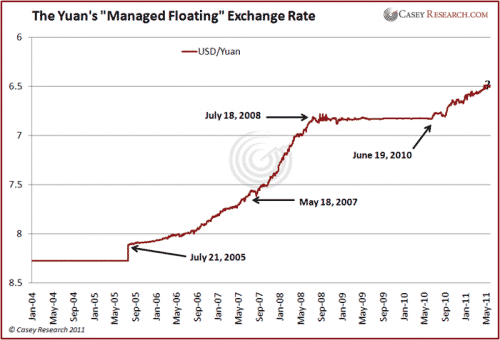Trade, Trial Balloons, and the Yuan
By Kevin Brekke
Just when the dust-up surrounding fraud allegations against Sino-Forest looked to have slipped off the front page ,we got hit with another "sino" announcement last week: China released its trade numbers for June. They showed a surplus of $22.3 billion – considerably wider than anticipated – and smashed consensus estimates.
China registered a trade deficit in the first quarter of this year, the first such occurrence in seven years. The quarterly deficit yielded some temporary cover for Chinese officials against the chronic calls by U.S. officials for further yuan appreciation. However, the deficit appears to have been a one-off event as a surplus re-emerged in roaring style in April and remained positive in every month since.
Like so many of today’s governments, China is struggling to attain a balance among many competing fiscal and economic forces. Often, policies used to tackle one area will aggravate another area. In particular, the juggling act between maintaining sufficient GDP growth to ensure ample job creation while also keeping inflation in check is now looking a little shaky.
In an effort to tamp down rising prices, the People’s Bank of China (PBOC) has raised interest rates five times since mid-October and increased banks’ reserve requirements numerous times to rein in liquidity. With inflation for June reaching 6.4%, a return to trade surpluses, and an expected 9%-plus rate of GDP growth this year, fears that monetary tightening would kill growth have subsided.
China’s inflation is not across all sectors and is being driven by rising prices for food, energy, and industrial commodities. Regardless of the source of inflation, it is a serious concern for Chinese officials. Chinese history shows that periods of high inflation are associated with social, economic, and political unrest – all things that the central planners in Beijing wish to avoid.
Toward that goal, the return to stronger export performance might provide a convenient pretense for another round of yuan appreciation. A strengthening yuan would lower the import cost of commodities and energy, both essential components throughout the food chain. China is the world’s biggest consumer of energy and soybeans, and its import bills have been soaring.
So, what are the odds that the yuan will be allowed to rise?
Managed Floating Exchange Rate
First, let’s take a look at the managed exchange rate of the yuan against the dollar, as it yields a chart unlike any other currency pair:
(Click on image to enlarge)
Since October 1, 1998, the yuan had been trading at a fixed rate of 8.27 to the dollar. The only variance in this rate happened at the third decimal point (.001). On July 21, 2005, the PBOC announced a revaluation to 8.11 per US$ – a 2% rise – and the switch to a managed floating exchange rate. The yuan would begin to trade in a 0.3% band around a midpoint to be announced daily by the central bank.
By May 18, 2007, the yuan had risen to 8.11 from 7.67 – a 5.4% gain – and China widened the daily trading band to 0.5% in response to criticism about the slow pace of yuan appreciation. The yuan would rise by 11% over the following year.
On July 18, 2008, with the yuan trading at 6.82, China announced a return to the dollar peg in response to the global financial crisis, intending to protect its export market. As you can see, the central planners are very efficient at implementing and maintaining a fixed exchange rate, with the rate returning to near flat-line stability reminiscent of the pre-2005 years.
Then on June 19, 2010, China announced a return to increased flexibility in the yuan exchange rate. The yuan had its largest one-day gain, 0.42%, since China adopted its managed floating policy in 2005 and hit 6.79 per dollar. The yuan has since steadily floated higher and trades today at about 6.46, a 4.8% gain.
Trial Balloons
With the exception of the July 2008 "crisis" announcement, changes in China’s management of the currency have been preceded by calls from academics and officials within the party for the currency to rise. And recently, in reaction to rising inflation levels in China, high-profile voices are again expressing similar sentiments and backing another rise in the yuan.
Of note, an official with the State Administration of Foreign Exchange said the trading band should be expanded to 1%. Premier Wen Jiabao has said that the exchange rate may play a role in controlling prices, and deputy central bank governor Hu Xiaolian said more yuan flexibility would ease inflation pressure. Two prominent Chinese state researchers also called on the government to use the yuan to help curb inflation.
Christy Tan, a foreign-exchange strategist at BofA-Merrill Lynch, observed, "The recent comments appear to have been sequenced deliberately," saying she thinks China is close to further currency loosening.
And if the history of the correlation between widening the trading band and yuan appreciation again holds, the currency could rise sharply in the months following any announcement on additional currency easing from the PBOC.
[Do you know about China’s secret plot against the U.S. dollar? Listen to this presentation, then take action to profit from this knowledge. A three-month trial subscription to BIG GOLD is risk-free – and your timing couldn’t be better.]

Comments are closed.